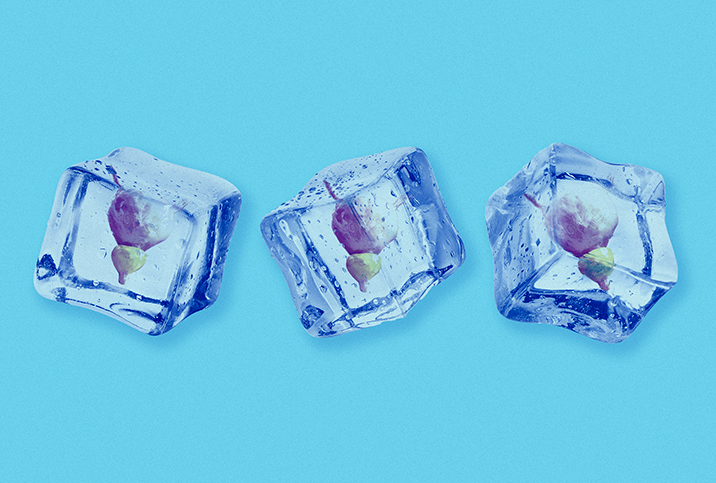Cold Facts About Prostate Cryoablation

In Vermont, subzero temperatures are the norm during the depths of winter. Kids there get used to anything wet on their bodies, such as a runny nose or damp hair after a shower, becoming frozen solid on the walk to school. The term "below zero" is nothing to fear when you hail from the Green Mountain State.
But I don't care how accustomed to the cold you are at 40 below zero, your nostrils freeze in a painful way, and the idea of having to urinate outside is terrifying.
Honestly, does anything good happen at such extremely cold temperatures?
It turns out, yes. A temperature of minus 40 degrees can be utilized to help heal the prostate from conditions as severe as cancer. The prostate, a walnut-shaped gland that sits below the bladder and in front of the rectum, produces fluid for semen, which transports sperm. Modern science has developed precise and effective ways to use freezing temperatures as a form of recovery and an alternative treatment to methods such as radiation or invasive surgery.
This form of freezing treatment is called cryoablation or cryotherapy.
"The first FDA approval for [cryoablation] was actually for the treatment of prostate cancer, primarily in a salvage setting," said Ashley Evan Ross, M.D., a Chicago-based doctor who specializes in urologic oncology.
He explained that a salvage setting means all the standard therapies have not worked so far and something else such as cryoablation is being tried.
Ablation refers to the removal or surgical excision of a body part or tissue. With cryoablation, extremely cold temperatures are used to freeze parts of the body. In this case, tumors and localized cancerous cells. The frozen tissue dies, cutting the cancer off from continued growth.
"Freezing works for prostate cancer and is shown previously to work for things like renal cell carcinoma, as well," Ross added. "It's basically taking the temperature in that area down to very low temperatures; usually it's minus 40 degrees Celsius or less."
Cryoablation is used in cases where other cancer treatments are not viable or have not effectively combated the disease, such as when cancer has not yet spread or does not pose a great risk of spreading to other parts of the body; for men who are not physically well enough to receive radiation treatments or undergo more invasive procedures; or when the goal is not necessarily the eradication of cancer but rather the easing of symptoms associated with the illness.
Cryoablation may also be utilized as an alternative when radiation has not proved effective. Ross, who works with patients at Northwestern Medicine, explained that cryoablation is sometimes used as a primary treatment for first-time prostate cancer patients who have not yet undergone radiation or surgical procedures.
"The real story in terms of cryotherapy has been that in the last five to 10 years—with MRI imaging and other things becoming more commonplace and more reliable—we have been using [cryotherapy] for focal therapy," he said of the therapy approved by the Food and Drug Administration. "Which is the idea that, instead of treating the entire prostate, we can just treat one section of the prostate."
Can it help with prostatitis?
Besides cancer, one of the most prominent conditions affecting the prostate is prostatitis, which causes the gland to become inflamed or swollen and is one of the most common urinary tract problems affecting men every year. The signs and symptoms of these two conditions can be similar, thus arousing understandable cancer concerns in many men experiencing prostatitis.
So if cryoablation works so well for one, it works for the other, right? Unfortunately, cryoablation isn't much of an option for people plagued by this particular type of inflammation and/or swelling.
"In some cases, we have guys who have chronic pelvic pain with no evidence of an infection. But they just have pain and they have prostatitis, which we call noninfectious inflammatory prostatitis," said Amin Herati, M.D., a urologist and an assistant professor of urology, gynecology and obstetrics at the Johns Hopkins University School of Medicine in Baltimore.
Noninfectious inflammatory prostatitis may have a number of causes: the immune system targeting the prostate, lingering inflammation following a bacterial infection or an endocrine response. Since cryoablation of the prostate is associated with possible unpleasant side effects—swelling, incontinence, bleeding, soreness and others—it is not typically recommended for treatment of prostatitis.
In extremely rare cases of the most common type of prostatitis, however, cryoablation presents a theoretical possibility for dealing with otherwise relentless pain.
The most common form of prostatitis
Chronic pelvic pain syndrome (CPPS), or chronic nonbacterial prostatitis, is the most common form of the condition, estimated to occur in as many as 1 out of 3 men. The pain that results from CPPS can manifest in the pelvis, the perineum or the genitals.
"In CPPS type three—that's the type that is the nonbacterial prostatitis—they are subgrouped into inflammatory and noninflammatory. So type 3-B is noninflammatory, and type 3-A is inflammatory," Herati said.
He said a number of different treatments, including antibiotics, anti-inflammatories, herbal therapies, physical therapies and even frequent ejaculation, can help alleviate symptoms of CPPS.
Herati went on to say that there may be another solution, albeit a somewhat extreme one, in the form of cryotherapy.
"If patients have persistence of pain despite all of those therapies, then there is consideration for using something to treat their pain instead of treating the source of their pain," he said. "Now, cryotherapy could be applied to the nerves that go to the prostate, what are called pudendal nerves."
Effectively, this would numb the nerve endings by ablation, thereby eliminating the pain. However, the idea of using cryoablation to treat CPPS is little more than just that: a theoretical idea. It's not necessarily one many doctors would consider, though a small study conducted recently in China suggested some success.
"By ablating the nerve endings, you're treating the pain," Herati said. "Now, cryoablation of the prostate would be a dangerous treatment option, so I would not recommend cryoablation of the prostate for this condition."
This sentiment was corroborated by several urological institutes and clinical oncologists, all of whom largely reflected Herati's thinking on the matter.
Conclusions about cryoablation
With the improvement of complementary tools such as magnetic resonance imaging (MRI) and the advancement of existing treatment options, cryoablation may be another tool in the arsenal for doctors working with prostate cancer patients.
Though it may seem extreme to use freezing temperatures to eliminate pain or sensation in nerve endings, the technology could—theoretically and with the right application—help treat chronic pain symptoms that shrug off other treatments. Given the pace of medical technology advancements, cryoablation is just one of many techniques that could evolve significantly in the coming decades.
That beats sitting on a snowdrift for relief.


















